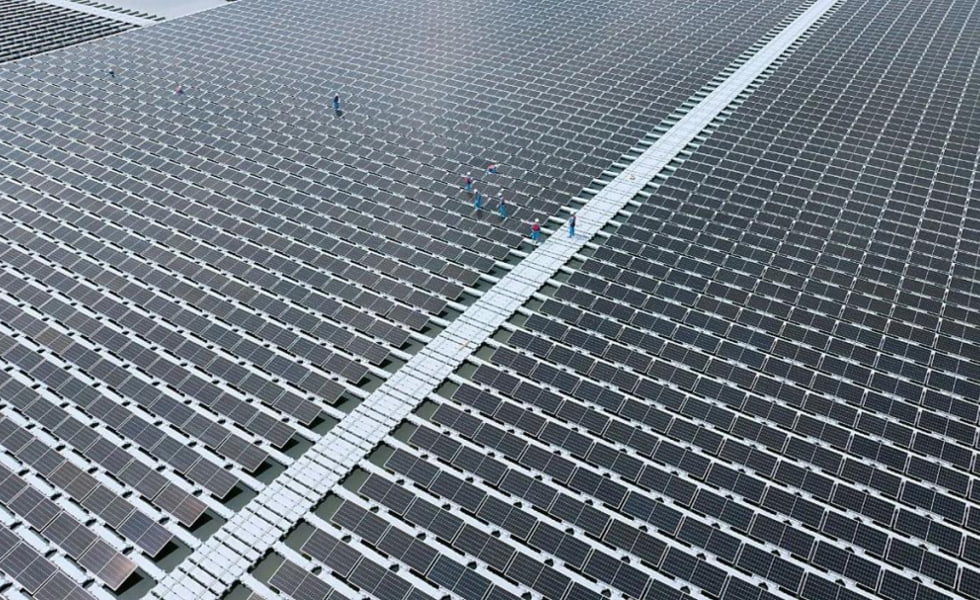
Impulsionada pela meta de "dual carbono", a transformação da estrutura energética do meu país está migrando da terra para o azul profundo. Recentemente, o projeto fotovoltaico flutuante totalmente em água do mar da Sinopec Qingdao Refining and Chemical foi concluído e colocado em operação. Este projeto é o primeiro projeto fotovoltaico flutuante totalmente em água do mar do meu país. Esta "Grande Muralha Azul", erguida na costa do Mar Amarelo, não apenas marca o avanço fundamental do meu país no desenvolvimento de novas energias marinhas, mas também destaca a lógica profunda da inovação tecnológica que impulsiona a revolução energética.
O projeto está localizado no Parque de Demonstração de "Produção, Pesquisa e Adição" de Refino e Energia Química de Hidrogênio de Qingdao, cobrindo uma área de cerca de 60.000 metros quadrados e uma capacidade instalada de 7,5 MW. O projeto utiliza todos os Painéis solares tipo N A estrutura fotovoltaica flutuante utiliza um design dinâmico no qual os painéis fotovoltaicos sobem e descem em sincronia com a maré, encurtando a distância entre o painel e a superfície da água para 1/10 da estrutura tradicional baseada em estacas. O layout próximo à água cria um "efeito de resfriamento da água do mar" exclusivo, que reduz a temperatura operacional dos componentes em 3 a 5°C e aumenta a eficiência de geração de energia em 5% a 8%. Após a conclusão do projeto, serão gerados 16,7 milhões de kWh de energia. eletricidade verde anualmente, reduzir as emissões de dióxido de carbono em 14.000 toneladas e reduzir o investimento em cerca de 10% em comparação com a energia fotovoltaica tradicional baseada em pilhas. A conclusão deste projeto não só marca um avanço fundamental no desenvolvimento de novas energias marinhas no meu país, como também abre um novo caminho para a transformação energética em cidades costeiras, ilhas e plataformas offshore de petróleo e gás.
Meu país tem um litoral de 18.000 quilômetros e 3 milhões de quilômetros quadrados de águas jurisdicionais. O potencial para o desenvolvimento de novas energias marinhas é enorme, e espera-se que ultrapasse 1 bilhão de quilowatts. Em 2025, a política propôs claramente "apoiar a aquicultura em águas profundas e a construção de fazendas offshore". Com o aumento contínuo das políticas nacionais, a estratégia do "celeiro azul" tem sido constantemente promovida, e o desenvolvimento integrado de "fazendas fotovoltaicas + marinhas" tornou-se a tendência dominante atual. Como principal fornecedor deste projeto, nos últimos anos, temos nos concentrado na inovação e na aplicação da energia fotovoltaica offshore. A energia offshore sistema flutuante de geração de energia fotovoltaica Utiliza materiais compósitos poliméricos semelhantes ao alumínio, desenvolvidos de forma independente. Comparada às usinas flutuantes de PEAD tradicionais, apresenta vantagens abrangentes significativas, incluindo alta proteção ambiental, alta resistência às intempéries, ausência de riscos de raios ultravioleta, erosão por altas temperaturas e névoa salina, excelente segurança, construção conveniente, etc. Pode aumentar significativamente a geração de energia por unidade de área, excelente resistência ao vento e às ondas e operação estável em condições marítimas adversas, proporcionando aos clientes os maiores benefícios em termos de valor.
